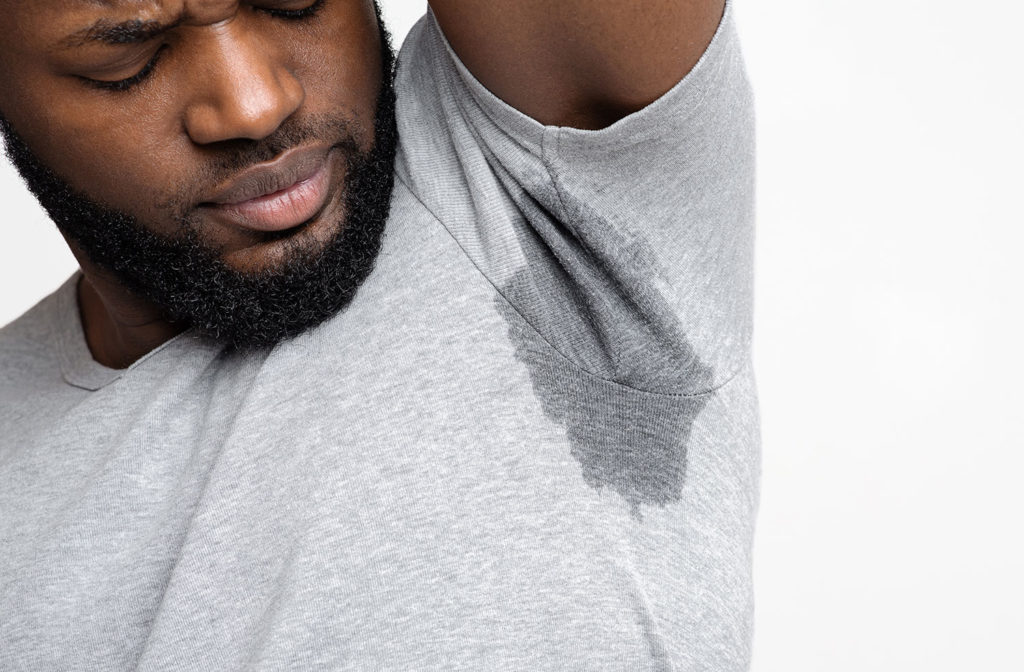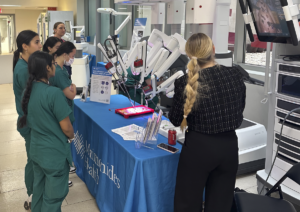Summary
Sweating is a normal part of our body’s temperature regulation system but some people may experience an abnormal amount of excess sweating that isn’t necessarily related to heat or exercise. Dr. Jason Shaw discusses excessive sweating, possible treatment solutions, and more.
Listen on Spotify Listen on Apple Podcasts Listen on Google Podcasts
Transcript
Prakash Chandran: Sweating is a normal part of our body’s temperature regulation system. But some people experience abnormally excessive sweating that’s not necessarily related to heat or exercise. They may sweat so much that it soaks their clothes and drips off their hands. Besides disrupting normal daily activities, this type of sweating can cause social anxiety and even embarrassment.
Here to tell us more is Dr. Jason Shaw. He’s currently the Director of General Thoracic Surgery at Maimonides Medical Center where he oversees surgical oncology and thoracic surgery.
This is my Maimo Med Talk. I’m your host, Prakash Chandran. So Dr. Shaw, thank you so much for joining us today. I truly appreciate your time. Can you actually define excessive sweating and tell us how someone knows the difference between normal and excessive sweating?
Dr Shaw: So that’s a great question, because obviously everybody sweats. But the main thing in simple terms is that hyperhidrosis is when the sweating is so severe that it affects your daily activities, basically whatever you’re doing in life to get through your day. And also for primary focal hyperhidrosis, the cause isn’t secondary to another process or disease entity. So it’s not, for example, somebody who’s going through menopause, who just happens to be having hot flashes and so forth. So more specifically, we usually consider it when patients have that kind of disabling sweating that’s been going on for at least six months without a known cause. And it often is accompanied by the fact that it’s symmetric. It’s not just on one side. As I said, it impairs your daily activities. It happens fairly often, not just occasionally or when it’s really hot, but at least once a week. Another characteristic, not necessary, but usually, the onset is before the age of 25. Often this happens with younger patients and sometimes it runs in families as well. So these are kind of the tip-offs that somebody might be suffering from hyperhidrosis.
Prakash Chandran: Okay. Got it. So hyperhidrosis really is that condition of excessive sweating. And we’ll get into the demographic information soon. But I’d love for you to maybe broadly talk about your expertise in this area and why you work on it.
Dr Shaw: So why I work on it is, as a thoracic surgeon, I was an early embracer of minimally invasive procedures. And while I take care of a lot of other conditions and people with cancer, early in my training, I encountered patients that were suffering from this debilitating disorder. And when it works, they are some of most grateful patients that you get to treat and the results are fairly quick. I also have some colleagues and their family members, their children have had this disorder and I’ve taken care of some of them through my career, and they’re very appreciative. And I don’t want to overshare, but I, myself, have sweaty hands. Fortunately, when I operate, I wear gloves. And I see that even in my own children, they have sweatier hands. And so I can identify with their experience of not wanting to shake somebody’s hands because you’re embarrassed. It’s going to be cold and clammy at an interview. Or, when your teenagers or going out on a first date, they don’t want to use their hands and stuff like that. So that’s kind of how I fell into this interesting niche of taking care of people with this disorder.
Prakash Chandran: Yeah, I think it’s so important and just kind of focusing a little bit more on your expertise in the area, you are the director of General Thoracic Surgery. And when people think of thoracic surgery, I don’t know that they think about hyperhidrosis or excessive sweating. So can you talk a little bit about how you specialize in hyperhidrosis?
Dr Shaw: So because the nerves that control sweating run through the chest cavity, the thoracic surgeon, has access to sort of that highway of the sympathetic chain that controls the sweating in certain levels and parts of your body. And so we see the sympathetic chain and sometimes the ganglia fairly often. So we’re comfortable in this area. And then, in terms of doing minimally invasive surgery, this has been a transformation over the last couple of decades. And so our comfort level with performing endoscopic or what they call thoracoscopic procedures where a small camera is introduced between your ribs and you’re able to visualize the entire chest cavity, including those nerves, has facilitated this type of surgery. And that’s kind of the evolution of it and how we’ve got to where we are in our understanding of treating this disorder and why chest surgeons are the ones that are often involved, particularly with the excessive sweating for the hands, palmar hyperhidrosis, which is an area that I really like to focus on.
Prakash Chandran: Yeah. You know, thank you for that explanation. I did not know that. I want to move on to the demographics of who this affects. Now, you touched on it a little bit earlier. You said typically before the age of 25, sometimes it runs in the family. But can you talk more specifically about the broader demographics of people that you see with hyperhidrosis? And is it consistent with the patients that come in to see you?
Dr Shaw: Yes. So very often, you hear stories where it starts in kids maybe around middle school or teenagers. Some learn to live with it and they don’t really realize that they’re suffering. We treat a pretty diverse population here in Brooklyn. And it is fairly common in Asian populations. And we do take care of a lot of Asian patients. And it’s fairly common, up to 5% of the entire population. That’s kind of the typical story that we’ll see, is somebody who’s either a young adult or somebody who’s a teenager, who said that really the onset started when they were maybe, 12, 13, 14, and they’ve been sort of dealing with it. But now, they’re in a situation where it’s really interfering with their job, with their life, whether it’s somebody who’s has to use their hands at work to operate equipment or a young mother, who’s trying to take care of their child and things are slipping. Or just somebody who’s working and typing and finding that the keyboard is getting wet and they can bearly type, that sort of thing. So, when you start hearing the stories, you realize how it’s not as uncommon as one would think.
Prakash Chandran: Yeah, 5% is a pretty big number. It’s much larger than I thought. And I think the thing to take away there is that people that might be listening to this that have it are not alone, right? There’s a lot of people that are going through it. So I want to talk a little bit about treatment. So broadly, is there a way to stop or control this excessive sweating without surgery?
Dr Shaw: Yeah, absolutely. And to be clear, surgery, while it plays a very important role, is not the first-line therapy. So the first-line treatments are non-surgical including things like antiperspirants, the mainstay being aluminum-based anti-perspirants, which can be applied topically. Additionally, there are some other treatments, including Botox injection locally, which some practitioners and often dermatologists utilize with some success. And there are other treatments involving effectively using electrical current in the treatment where it sort of goes through almost water. And if you can put your hands there for a while, it can diminish the amount of sweating from the sweat glands in your hands. But those are usually treatments that my patients have already gone through before they come to me, before they get to me. There’s a wider array of these treatments. There’s also a medical treatment, a class of medications called anticholinergics and that can sometimes help. But again, there are side effects with those oral medications.
Prakash Chandran: So let’s say they’ve tried everything that you’ve just mentioned, but it might be time to consider surgical solutions. Can you talk about when someone might need to consider it and what they look like?
Dr Shaw: So it’s a day procedure. And because again hyperhidrosis affects both sides of the body, we do it on both sides sequentially. So for example, I’ll tell a patient that they’ll come in to the hospital in the morning and it’s done under general anesthesia. But it usually takes typically about eight minutes per side, if that, in terms of the actual operating time.
And so they’ll lie down on the operating room table. They’ll be sleeping, don’t hear anything. And we use generally two 5-millimeter incisions, very small, and we’ll go in. We’ll identify the nerve at the correct level to be transected, which means divided. And we sew the holes close with a little glue and then we do the other side. So usually, it takes about 20 minutes and the patients wake up and then they go to the recovery room. And very often, you’ll see their hands are dry immediately after the surgery. They’ll see the results, almost instantaneously.
Prakash Chandran: That’s amazing. Are there ever any funky side effects or outcome that patients need to be aware of after the surgery?
Dr Shaw: Absolutely. So the biggest side effect is compensatory sweating. And there’s a good amount of literature to suggest that the higher the level that you divide, the more likely that is to occur. And so, for example, that’s why I don’t really do this procedure for facial hyperhidrosis or even axillary. I really try to concentrate on the palmar. And the compensatory sweating is really a trade off, because your hands will be nice and dry, but there’s always a chance, and I’d say depending on the studies and who’s doing the operation, anywhere from 30% to 50% or even 60% of patients may have an additional area on their body that sweats a little bit more. The severity is somewhat variable and not always predictable. But generally, the patients are much happier to be able to have nice dry hands that aren’t interfering with their lives in terms of what they need to do versus having a small patch on their skin, often on their trunk, occasionally on their thighs or legs where there’s increased sweating.
There are other surgical complications, which are exceedingly rare, especially if you’re having this procedure performed in a center by a surgeon that has experience with this in terms of just some local soreness at the surgical sites and the usual type of surgical complications.
Prakash Chandran: So one of the things that you mentioned there is the experience of the surgeon. And one of the final questions that I wanted to ask you is what makes Maimonides a unique place to get treatment? Is there anything that patients should understand about Maimonides or any value adds that patients should think about as they make their considerations?
Dr Shaw: Maimonides is the largest tertiary care hospital in Brooklyn. And so our thoracic surgical department is robust. We have four thoracic surgeons, all of whom are proficient in minimally invasive techniques. And I think that we strive to individualize treatments and therapies to the patients and work closely with patients and their families to ensure that they get the best treatment that they deserve right here in Brooklyn locally. We also have some other patients that come and even travel to us from some of the other boroughs actually. But I think that’s the fundamental thing about it that makes it good. We have state-of-the-art operating rooms, excellent doctors that we work with in terms of our anesthesia colleagues. And the peri-operative care is excellent as well.
Prakash Chandran: Well, Dr. Shaw, I think that is the perfect place to end. Thank you so much for your time today. I truly appreciate it.
Dr Shaw: You’re very welcome. I hope that my thoughts can help some of the people out there. And I look forward to talking to you again.
Prakash Chandran: Absolutely. That was Jason Shaw, Director of General Thoracic Surgery at Maimonides Medical Center. To learn more about this topic, you can visit maimo.org and that is M-A-I-M-O dot org. You can also call 7 1 8 2 8 3 8 4 7 1 to make an appointment. This has been Maimo Med Talk. I’m your host, Prakash Chandran. Stay well.







